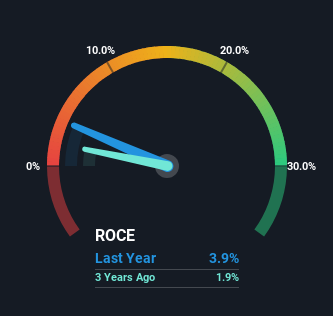Be Wary Of Sichuan Langsha Holding (SHSE:600137) And Its Returns On Capital
If you're looking at a mature business that's past the growth phase, what are some of the underlying trends that pop up? More often than not, we'll see a declining return on capital employed (ROCE) and a declining amount of capital employed. This indicates the company is producing less profit from its investments and its total assets are decreasing. So after we looked into Sichuan Langsha Holding (SHSE:600137), the trends above didn't look too great.
Return On Capital Employed (ROCE): What Is It?
Just to clarify if you're unsure, ROCE is a metric for evaluating how much pre-tax income (in percentage terms) a company earns on the capital invested in its business. The formula for this calculation on Sichuan Langsha Holding is:
Return on Capital Employed = Earnings Before Interest and Tax (EBIT) ÷ (Total Assets - Current Liabilities)
0.039 = CN¥21m ÷ (CN¥687m - CN¥147m) (Based on the trailing twelve months to March 2024).
Therefore, Sichuan Langsha Holding has an ROCE of 3.9%. Ultimately, that's a low return and it under-performs the Luxury industry average of 6.5%.
Check out our latest analysis for Sichuan Langsha Holding

Historical performance is a great place to start when researching a stock so above you can see the gauge for Sichuan Langsha Holding's ROCE against it's prior returns. If you'd like to look at how Sichuan Langsha Holding has performed in the past in other metrics, you can view this free graph of Sichuan Langsha Holding's past earnings, revenue and cash flow.
So How Is Sichuan Langsha Holding's ROCE Trending?
We are a bit worried about the trend of returns on capital at Sichuan Langsha Holding. Unfortunately the returns on capital have diminished from the 5.2% that they were earning five years ago. And on the capital employed front, the business is utilizing roughly the same amount of capital as it was back then. Since returns are falling and the business has the same amount of assets employed, this can suggest it's a mature business that hasn't had much growth in the last five years. If these trends continue, we wouldn't expect Sichuan Langsha Holding to turn into a multi-bagger.
The Bottom Line
All in all, the lower returns from the same amount of capital employed aren't exactly signs of a compounding machine. Investors haven't taken kindly to these developments, since the stock has declined 16% from where it was five years ago. That being the case, unless the underlying trends revert to a more positive trajectory, we'd consider looking elsewhere.
Since virtually every company faces some risks, it's worth knowing what they are, and we've spotted 2 warning signs for Sichuan Langsha Holding (of which 1 is a bit concerning!) that you should know about.
While Sichuan Langsha Holding isn't earning the highest return, check out this free list of companies that are earning high returns on equity with solid balance sheets.
New: Manage All Your Stock Portfolios in One Place
We've created the ultimate portfolio companion for stock investors, and it's free.
• Connect an unlimited number of Portfolios and see your total in one currency
• Be alerted to new Warning Signs or Risks via email or mobile
• Track the Fair Value of your stocks
Have feedback on this article? Concerned about the content? Get in touch with us directly. Alternatively, email editorial-team (at) simplywallst.com.
This article by Simply Wall St is general in nature. We provide commentary based on historical data and analyst forecasts only using an unbiased methodology and our articles are not intended to be financial advice. It does not constitute a recommendation to buy or sell any stock, and does not take account of your objectives, or your financial situation. We aim to bring you long-term focused analysis driven by fundamental data. Note that our analysis may not factor in the latest price-sensitive company announcements or qualitative material. Simply Wall St has no position in any stocks mentioned.
About SHSE:600137
Sichuan Langsha Holding
Manufactures and sells knitted underwear and fabrics for men, women, and children in China.
Flawless balance sheet with proven track record.
Market Insights
Community Narratives



